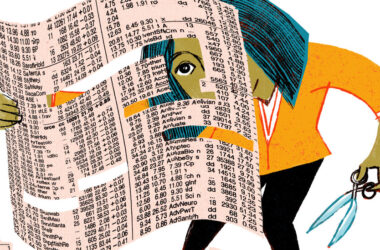Wall Street strategists are issuing forecasts for the performance of the stock market in 2024.
Pay them no mind.
The predictions are usually wrong, and when they’re right it’s only by accident.
Consider their prophecies for 2023. At the end of 2022, strategists predicted that the S&P 500 would end 2023 at 4,078, a gain of 6.2 percent from where it started, according to data from Bloomberg.
At the moment, the market is above 4,700, a gain of more than 22 percent. These forecasts were so deeply off the mark undoubtedly because 2022 was a truly terrible year for stocks — and also one that most analysts totally failed to foresee. So the predictions for 2023 were uncharacteristically modest, reflecting the gloom that prevailed when they were being set.
The median forecast on Dec. 19 called for the S&P 500 to close 2024 at 4,750, according to Bloomberg. The projections are still shifting — and will assuredly increase if the market keeps rising. When the market rises, the forecasts typically rise, too.
These forecasts aren’t scientific, and I only bother to address them at all because they get a tremendous amount of coverage, and they inform the advice given to thousands, and perhaps millions, of people.
If you find them entertaining or otherwise illuminating — wonderful. Enjoy them.
But at all costs, don’t take them at face value because there is no evidence that anyone can predict the market’s movements reliably, and a great deal of evidence that buying and selling stock on the basis of your views about the market’s impending movements is a fool’s game.
Better to invest with humility: Accept that no one knows where the market is going moment by moment, and focus on the long haul, anyway.
The Big Picture
Over many decades, the entire global stock market has trended upward, and as long as capitalism survives, and companies continue to profit, the stock market as a whole is likely to climb. But it certainly won’t do so all the time. If you’ve been in the market at all, you know that it rises and falls. These movements are, for the most part, unpredictable.
Yet Wall Street strategists make predictions anyway, despite a track record that is extraordinary in its ineptitude.
Back in 2020, using data compiled by Paul Hickey, a founder of Bespoke Investment Group, I found that since 2000 Wall Street frequently got the direction of the market wrong. At my request, Mr. Hickey has updated the data.
The numbers show that from 2000 through 2023, the median Wall Street analyst forecast that the S&P 500 would rise 9 percent a year, on average. In reality, the annual increase averaged 6 percent.
Even these figures understate the degree of failure.
In 2018, for example, the market fell 6.9 percent, though the forecasters said it would rise 7.5 percent, a 14.4 percentage point difference. In 2002, the forecast called for an increase of 12.5 percent, but stocks fell 23.3 percent, a spread of almost 36 percentage points.
And in 2022, the forecast called for an annual increase of 3.9 percent. But the stock market lost 19.4 percent. The forecasters were wrong by a margin of more than 23 percentage points.
Taking gaps like these into account, the median Wall Street forecast from 2000 through 2023 missed its target by an average 13.8 percentage points annually — more than double the actual average annual performance of the stock market.
The Situation Now
Many Wall Street strategists are astute analysts of what has already happened. But the economy and the markets shift constantly, in unexpected ways. Reliably forecasting stock market averages 12 months in advance is beyond anybody’s ability.
Declining inflation combined with a robust labor market has led many people to believe that the Federal Reserve will soon be cutting the short-term interest rates that it controls directly. This is seen as bullish for the stock market, which has risen in the past couple of months. The S&P 500 is on the verge of surpassing its last peak, reached in January. And if there is no recession in the next year, and interest rates do decline, it’s reasonable to think that the market will keep rising.
That, in a nutshell, is the bullish case. But it’s easy to conjure up bearish alternatives, too.
For example, if the Fed cuts interest rates prematurely, inflation could surge. The central bank may then need to raise interest rates again, as Paul A. Volcker, the former Fed chair, had to do in 1981, setting off a second recession in two years.
A “soft landing” for the economy in 2024 could be coming. But so could a recession.
David Rosenberg, a veteran strategist and economist, is still predicting one, as he has since early 2022. He expects the economy to falter, interest rates to plummet and stocks to fall. “Treasury bonds, not the stock market, will be the best performing asset class in 2024,” he told me in an interview.
Given the complexity of the world and all of the crises, big and small, that are already obvious, it would take a very long column to sketch out all of the things that could go wrong with a forecast about the next year. And I’m certain that there will be major shifts that few people yet imagine.
Fortunately, you don’t have to know these things to be a successful investor.
The key, first of all, is to have enough money set aside to pay the bills, because investment involves some risk, and you don’t want to take risks with money you absolutely need. Then, to minimize your risks while holding stocks, resolve to invest in the entire market for decades through low-cost diversified index funds, and avoid any attempt at timing the market. Wall Street predictions might tempt you to buy and sell at the wrong times. It’s safer to ignore these forecasts entirely.
Stocks are just part of the program. I also invest in high-quality bonds and do so the same way, with broad, low-cost index funds. Investment-grade bonds, and especially Treasuries, usually provide a buffer when stocks fall (though they didn’t do so in 2022). Treasuries, in particular, are safe investments, despite the fiscal strains resulting from the failure of the U.S. government in recent years to reach consensus on spending and taxation policies.
I find these forecasting exercises fascinating, and sometimes learn a great deal from them, but I don’t expect any of them to provide a road map to the future.
Hope for the best, prepare for the worst and get on with life. Unfortunately, Wall Street forecasts won’t help with any of that.




